Things to Know Before Buying a Blue Heeler
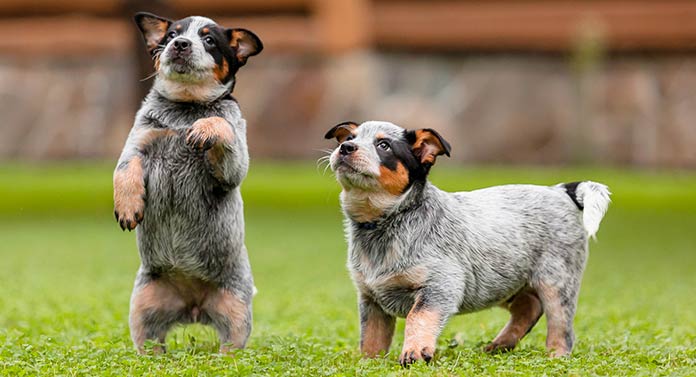
The Blue Heeler is a name for the Australian Cattle Dog breed. These short coated, blue patterned dogs have upright ears and deep eyes. They are intelligent, active and loyal. This traditional Australian herding breed was used for driving cattle along by nipping at their heels. Also known as the Queensland Heeler, the Blue Heeler dog is also a good pet for large, active homes, but they thrive in high energy, working environments. Today we are going to get to know the Blue Heeler's breed traits. We'll help you to decide whether this clever dog is right for your family, kids and lifestyle. And give you the information you need to raise an affectionate Blue Heeler puppy to be a healthy, happy adult dog with a long lifespan.
- Blue Heeler pros and cons
- What do Blue Heelers look like?
- Do Blue Heelers shed?
- Are Blue Heelers good pets?
- Blue Heeler training and exercise
- Adopting, buying and rescuing Blue Heeler puppies
- Caring for an Australian Cattle dog puppy
The Blue Heeler is never going to be a lap dog or ideal apartment pet, but they can fit very well with active working lifestyles. Not suited to first time owners, they are wonderful companions for experienced dog trainers and handlers. They are easy to train if you know how to motivate them, but need a huge amount of exercise for their bodies and brains!
Pros And Cons of Getting A Blue Heeler
| PROS | CONS |
| Clever | Can be destructive when bored |
| Easy to train | Need lots of exercise |
| Loyal | Wary of strangers – need lots of socialization |
| Require minimal grooming | Prone to inherited eye and joint problems |
Fun Facts About Blue Heeler Dog Breed
- The current oldest dog ever according to Guinness World Records is an Australian Cattle Dog. The Blue Heeler dog, Bluey lived for 29 years and 5 days.
- Like their Dalmatian relatives, Blue Heelers are often born completely white.
- Two celebrities famous for their Australian Cattle Dogs are actors, Owen Wilson and Matthew McConaughey
- If you look closely, you'll find Blue Heelers in the movies, Mad Max and Brokeback Mountain
History and Original Purpose of the Blue Heeler
Blue Heelers were originally bred by settlers in Australia, who crossed their dogs with dingos and created a unique, tough, hard working cattle dog, suited to the outback. These days they are an increasingly popular pet, too!
Although the Blue Heeler might look like a hunting dog, Australian Cattle Dogs were actually bred to create a herding dog. This was especially for the Australian environment after British settlers emigrated there in the 19th century. Their unique appearance is partly down to the wild dingo blood running through their veins.
Wherever Dingos and domestic dogs have existed in close proximity, a certain amount of cross breeding has occurred. However, it's no coincidence that Blue Heelers are somewhat dingo-like in appearance—the dingo blood in these cute cow dogs is no accident. Dingos were deliberately bred with the Blue Heeler dog to create a specific result. That is, the kind of tough dog that Australian cattlemen needed.
In addition to Dingos, you'll find traces of other breeds in a Blue Heeler's genetic makeup. These include the Blue Smooth Highland Collie, Bull Terrier, Dalmatian, and black and tan Kelpie. The breed received official recognition from the American Kennel Club in 1980.
What does a Blue Heeler look like?
Healthy adult Blue Heelers can weigh between 30 and 50 pounds. They can be up to 20 inches tall, but females are smaller than males.
It's unusual to see a fat Blue Heeler, because they are such active dogs and don't tend to be over eaters. If your Blue Heeler is always hungry then try spreading out their meals more, into smaller portions with the same daily total. And don't forget to use lots of their kibble as as training treats.
With upright ears, short fur, and a balanced, athletic body, the baby Blue Heeler resembles the Australian Dingo. However, their bodies tend to be more muscular. Their ears may be initially floppy as puppies, but often become perky before 24 months.
Blue Heeler Coats
The Australian Cattle Dog has a short, straight coat with many different shades. They also have an even shorter undercoat. Their fur is relatively rough to the touch. This is useful as it protects them from harsh weather conditions like rain or extreme heat. And in good news, your Blue Heeler is never going to need a haircut!
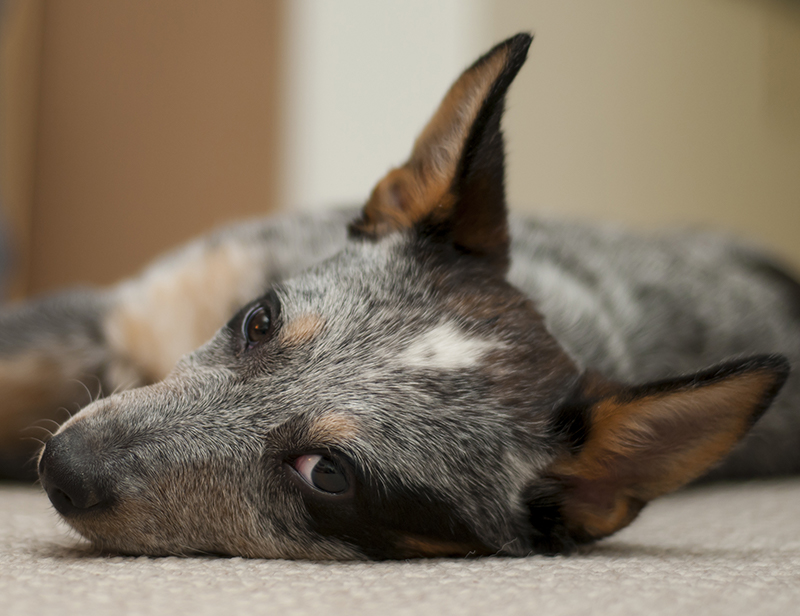
Australian Cattle Dog Colors
This breed comes in two main colors—red or blue. Some people refer to all Australian Cattle Dogs as Blue Heelers, regardless of their coat color. But some prefer to call the redder looking dogs Red Heelers or even Golden Heelers when it has a more ginger tone.
Blue Heeler colors, coat markings and patterns vary depending between dogs. They can often leave the dog looking like a mixture of the two colors. It is also common (and very cute!) for Australian Cattle Dogs to have a mask of darker fur over one or both eyes.
Do Blue Heelers Shed?
Australian Cattle Dogs shed a lot of fur, but their short coat is relatively easy to maintain. You should groom your Blue Heeler regularly to remove old hair and encourage new growth. This will help to reduce the amount of hair shed onto your carpets, but it won't prevent your Blue Heeler shedding altogether.
Are Blue Heelers Hypoallergenic?
Hypoallergenic dogs are sadly a bit of a myth. The thing that makes you sneeze is actually their dander, and comes from drool and skin flakes, not just the fur. However, some dogs are easier on allergy sufferers than others. Sadly, this cow dog isn't one of them.
Blue Heeler Temperament
Blue Heelers are packed with personality, but they need a lot of space and time focussed on them. This is not an apartment dog for a person that goes out to work.
The Australian Cattle Dog is a tough breed both mentally and physically. A 2007 study tracked Blue Heelers and other cattle dogs engaged in mustering sessions lasting four hours or more in temperatures of up to 38 degrees celsius. During the sessions, these dogs covered average distances of up to 20 miles.
Are Australian Cattle Dogs Aggressive?
Like many herding breeds, the Blue Heeler has a very loyal personality. They can be quite protective of their family and toys, and wary towards strangers. Plenty of early socialization helps to reduce the "wariness" but won't dispel it altogether. So the chances are your Blue Heeler dog will always be somewhat cautious around strangers and prefer familiar faces. This wary temperament makes socialization extra important when raising a Blue Heeler puppy.
Do Blue Heelers Make Good Family Pets?
Australian Cattle Dogs make great pets if you can to give them the exercise and mental stimulation they require to stay healthy and happy. But they are best suited to homes without very small children. Raising a Blue Heeler with kids is tough as you need to separate them a lot.
They are loyal to their owners and are full of personality and love. However, you must be wary of their inherent desire to herd—they often try to herd running children and can be prone to nip at passing legs. So whilst they can make great pets if you have the time and energy to dedicate to their healthy lives, you will need to always supervise these dogs around smaller children. It's vital to properly socialize your Blue Heeler to children of a wide variety of ages, before their socialization window closes at 14 weeks old.
Are Blue Heelers Good With Babies?
No dog should be trusted around babies. Although Instragram might be full of seemingly cute images of them curled up together, this actually isn't fair on the dog. Babies make sudden gestures, grab and don't let go, and emit weird high pitched noises. Don't put your dog in the position of having to understand what's going on and act accordingly. Just keep them apart or fully supervised until the baby is bigger.
Are Blue Heelers Good with Cats?
Blue Heelers and cats are not natural friends, due to the high prey drive of the cattle dog. Although they can learn to live together if they grow up together, don't rely on your Heeler accepting other cats as happily.
Blue Heelers and Other Animals
A reader asked: "We are considering adopting an 8-year-old female blue heeler. Does this breed kill cats and/or chickens?" Blue Heelers can often be taught to get along with other animals in the home. Especially when introduced careful, and at the right age.
Bearing in mind the herding instincts of Australian Cattle Dogs, it is wise to exercise care when introducing new animals. Dog training experts recommend introducing cats or other animals in puppyhood. And new animals may need to be introduced cautiously—perhaps using a protective fence at first.
Australian Cattle Dog Puppy Exercise
Although active dogs, it's important not to over exercise them at a young age. This has the potential to damage their joints and isn't good for their growing bodies. No more than five minutes per day of formal exercise per month old your puppy is, twice a day. That means a 6 month old Blue Heeler should have at most 30 minutes of exercise morning and evening.
Adult Blue Heeler Exercise
Because Australian Cattle Dogs are so intelligent, they require activities that stimulate them physically and mentally to take up their spare time. Activities and games such as retrieving and tracking will maintain the focus and quick responses of your dog. Without things to do, your pup may get bored and could start misbehaving to occupy itself.
Australian Cattle Dogs require lots of exercise to keep them happy and healthy. For this reason, Blue Heelers are not usually suited to living in small apartments. And if your dog is to have free run of your yard you'll need a secure dog proof fence to prevent them from wandering. These dogs are agile and do not tire easily—all qualities that make them such great herders.
How fast can a Blue Heeler run?
It's generally thought that like most herders, cow dogs can run somewhere between 25mph to 30mph. But take this with a pinch of salt, because I can't find any evidence of it actually being tested!
Do Australian Cattle Dogs like water?
All dogs can swim, and Blue Heelers are no exception. Although they weren't raised or bred as water dogs, being from quite dry areas, they are still able to swim. And if introduced at an early age can learn to love it, and burn off a lot of their energy doing so.
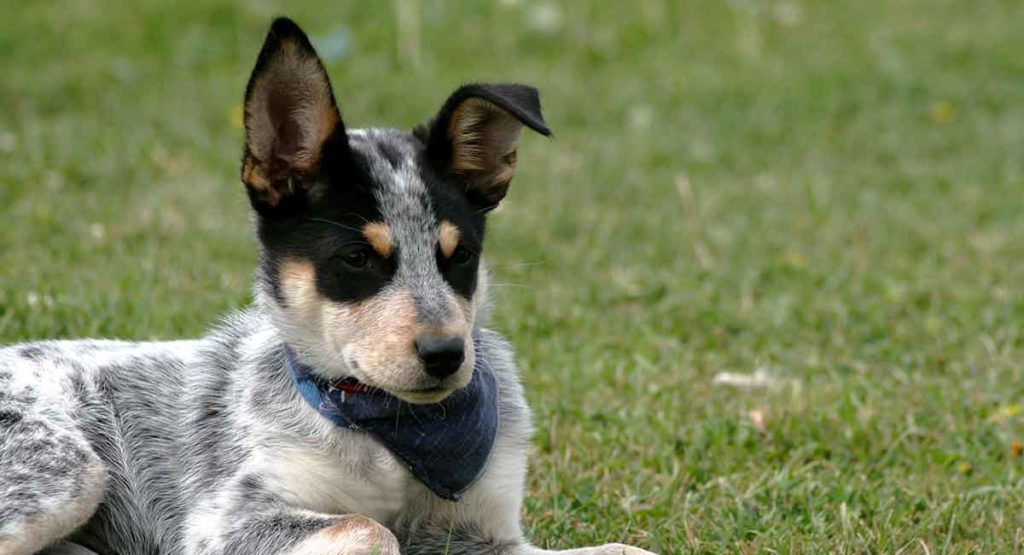
How to Train an Australian Cattle Dog
Australian Cattle Dogs are an extremely intelligent breed, that take quickly to training. Positive reinforcement training is a must for this clever and enthusiastic breed. Clicker and reward-based training is a great way to train dogs like these, and goes hand in hand with proper socialization in the first few years of your dog's life to ensure an obedient, friendly dog later in life.
Do Blue Heelers run away?
Although loyal and not particularly flighty dogs, you still need to teach them a good recall. An intact male Blue Heeler is likely to stray if they smell a female Blue Heeler in season. And any herding dog worth their salt has a high prey drive and needs to be taught a very solid recall.
Blue Heeler Health and Care
It's important to be aware of health issues that may affect your favorite breeds. Because in some cases, these can be entirely avoided by proper health testing. And in others, early diagnosis offers a better outlook for the dog.
Blue Heeler health risks to be aware of:
| Ears: | Inherited deafness |
| Liver: | Portosystemic shunt |
| Eyes: | PRA, lens luxation |
| Joints: | Hip and elbow dysplasia, Osteochondritis Dissecans |
Progressive Retinal Atrophy
Blue Heelers are prone to inherited eye troubles. Progressive Retinal Atrophy (PRA) LINK causes slow, painless loss of sight until the dog is completely blind in both eyes. This can take as long as several years or as little as several months. Fortunately, we now have tests which can identify dogs carrying the PRA gene, and there is no reason today why any puppy should develop the most common forms of this disease. All reputable breeders use these tests to screen their breeding stock. So, your main defense against PRA is finding a responsible breeder.
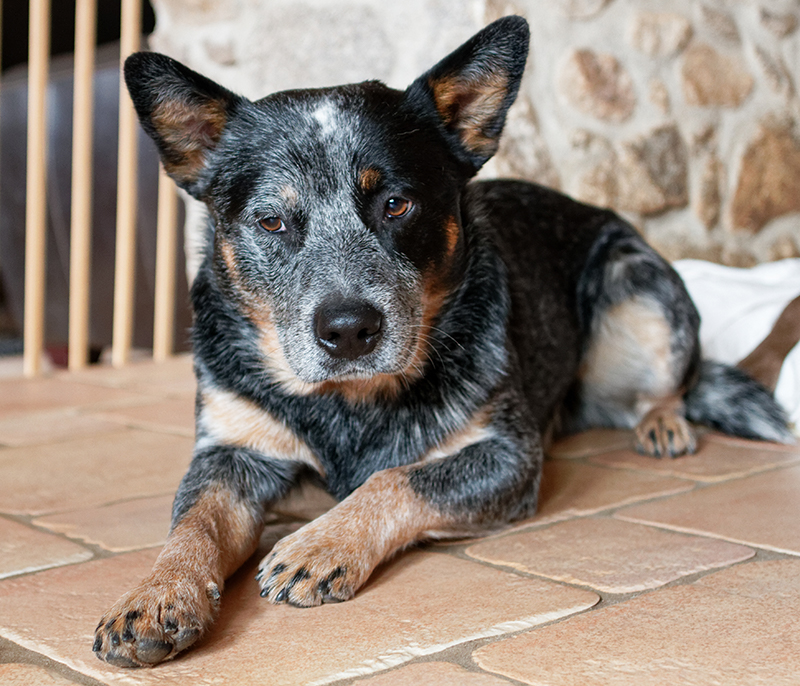
Lens Luxation
Australian Cattle Dogs are prone to an inherited condition called Primary Lens Luxation. The ligaments holding the lens in place in the eye break, and the lens moves partially or completely out of position. The lens can then get stuck at the front of the eye where it causes acute pain. Without surgery, this will lead to irreversible loss of sight.
Joint Problems in Australian Cattle Dogs
Australian Cattle Dogs are also prone to common diseases that affect the joints of many dog breeds.
Canine Hip Dysplasia
For example, they can suffer from canine hip dysplasia. This is where the hip joints do not develop properly and grind together rather than moving smoothly. Depending on the severity of their condition, an affected dog could require surgery or physiotherapy. They may have reduced mobility, and pain on exercise.
Screening is helping to reduce the incidence and severity of this disease. It is essential to make sure both parents have good 'hip scores' when buying a baby Blue Heeler.
Elbow Dysplasia
Another joint disease that often affects Australian Cattle Dogs is elbow dysplasia. The elbow develops in the wrong shape, causing pain and loss of function. It is caused by a combination of factors including inheritance – dogs whose parents have good elbows are less likely to develop elbow dysplasia themselves. Elbow dysplasia may require surgery.
Osteochondritis Dissecans
Blue Heelers are also prone to Osteochondritis Dissecans (OCD). The cartilage in the joint, at the end of the bones, does not develop correctly. Over time the diseased cartilage splits away from the bone. The cause is unknown. Any lameness in Blue Heelers should be investigated by your veterinary practitioner.
Avoiding Blue Heeler Joint Disease
The risk of joint problems can't be eliminated entirely by health testing, because these diseases don't have a simple, clear cut mechanism of inheritance. They're also influenced somewhat by environmental factors such as diet and exercise. So, instead of a gene test, parent dogs are tested for early signs of the disease. Then they're given a score that good breeders use to select their breeding stock.
To give your puppy the best chance of growing up with healthy joints:
- Choose a breeder who can share the parents' hip and elbow scores with you
- Keep your puppy slim
- Avoiding hard exercise while he is still very young.
If you do get an Australian Cattle Dog, also take your dog for regular check-ups with your vet to make sure they are not developing these or any other health problems. Let's take a look now at a couple of health issues more common in Blue Heelers than most other breeds.
Blue Heeler Deafness
Australian Cattle Dogs can suffer from congenital hereditary sensorineural deafness (CHSD). In a study of just under 900 Australian Cattle Dogs, published in 2012, over 10% of Blue Heelers had some degree of deafness. 3% of all the dogs were deaf in both ears.
An association between coat color and deafness has been noted in several breeds but the pattern and mechanism of inheritance is not always the same. In Blue Heelers, dogs with masks and females were at higher risk than dogs without facial masks or male dogs. In Australian Stumpy Tailed Cattle Dogs, which are related to Blue Heelers, some association has been found between speckled markings in the coat and deafness. However, a link between coat markings/color and hearing has not yet been proven in Blue Heelers.
Deaf Dog Training
Many owners of deaf Blue Heelers have learned to use signs to communicate. But if you'd prefer to avoid purchasing deaf Blue Heeler puppies, visit a knowledgeable breeder. Bilateral deafness can be identified by an experienced breeder by about six weeks of age. Blue Heeler puppies with deafness in only one ear are harder to detect, but also less of a challenge to train and care for.
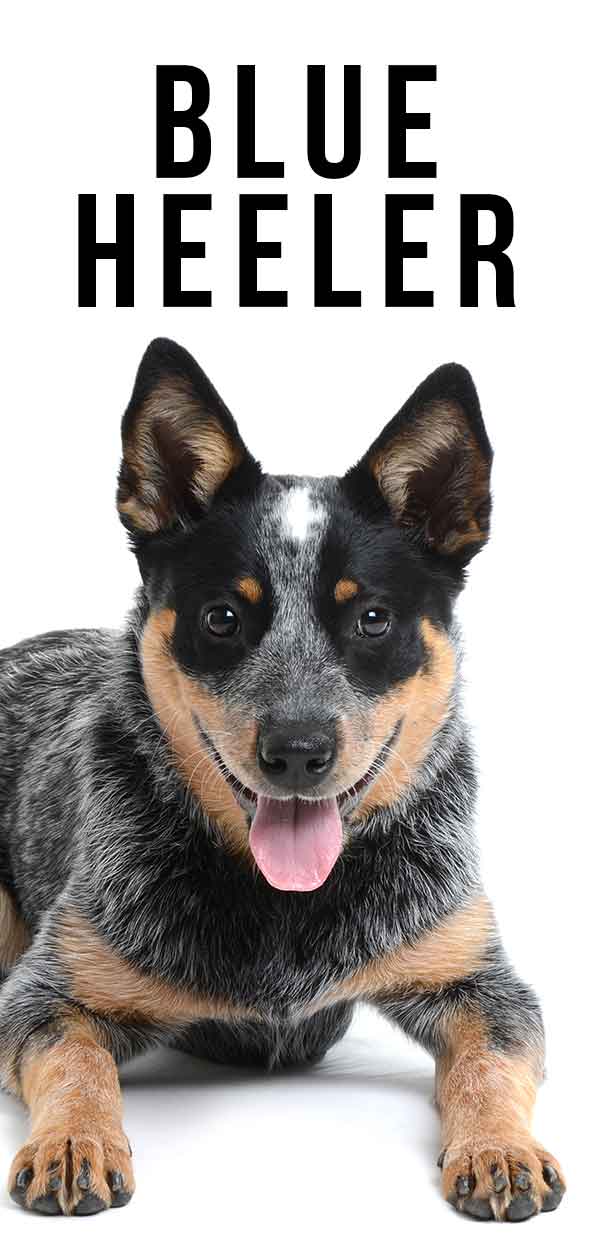
Blue Heeler Portosystemic Shunt
One further health problem we should mention is a condition that causes abnormalities of the blood flow in the liver. The liver is an important filter and removes toxins from the bloodstream. This keeps your dog's blood clean and healthy, just as it does in people. A portosystemic shunt means that the blood flow is literally "shunted" back into the bloodstream instead of passing through the liver. So the liver never gets a chance to remove those toxins, and the organ itself fails to grow properly.
Fortunately, in this inherited type of shunt, surgery can offer a successful outcome Dogs with a liver shunt may fail to thrive and suffer a range of symptoms. Therefore, it's very important to consult with your vet if your puppy is not growing as he should or seems unwell. Early treatment is important.
Blue Heeler Lifespan
The Blue Heeler dog has a reasonable lifespan for a purebred pup. They are often quoted as living 12-16 years. This is likely to be based on a study published in 2004, that included 22 blue Heelers. The dogs that had died (eleven of them) reached a mean age of twelve years. The oldest of those eleven dogs lived to be sixteen years of age. With such a small sample we can't draw any firm conclusions, but this is a breed with a sound conformation. So, hopefully, your Blue Heeler will be with you for a decade or more.
Rescuing a Blue Heeler
Adopting a puppy is often a wonderful experience for all parties involved. We have some information on dog rescue here. And you can find some rescue societies below:
Blue Heeler Breed Rescues
If you know of a Blue Heeler rescue center that's not on our list, you can let us know in the comments below!
Australian Cattle Dog Breeders
Finding a good breeder of Blue Heeler puppies is one of the most important steps you can take in your search for a puppy. This is because, as mentioned before, many health problems with these dogs are genetic.
There are over 80 different diseases in dogs for which we have DNA tests available. And that number continues to climb. Your best protection, therefore, is to know what tests apply and to find a responsible breeder who has selected their breeding stock with care. Use our puppy search series to guide you.
Always visit your breeder and their puppies before deciding. Moreso, always go to a breeder prepared to ask questions. Make sure you're satisfied that they've given you enough information before proceeding. A reputable breeder will be happy to share all of the parents' test results with you, as well as letting you meet both parents, and see the puppies in their home.
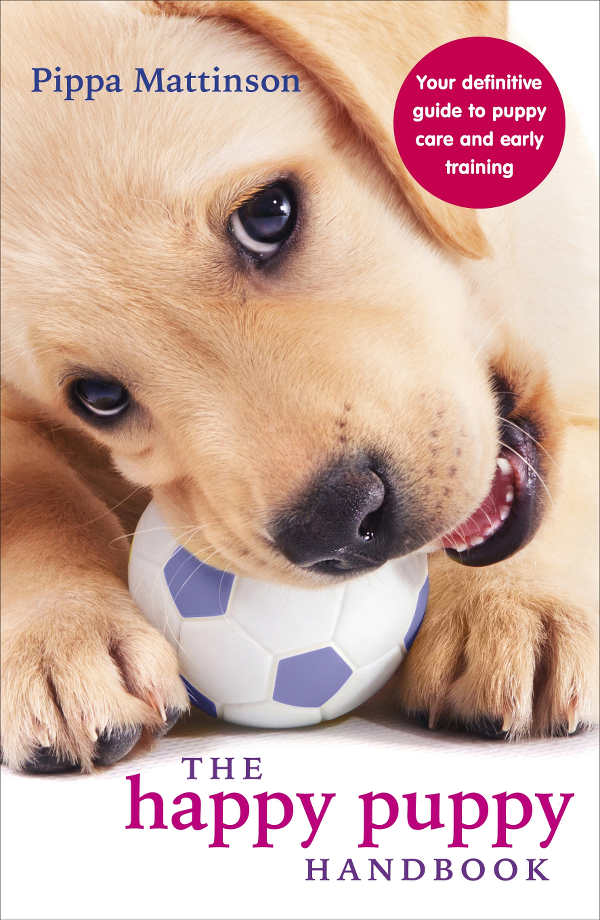
Good breeders will also usually question you, to make sure their puppy is going to a good home. They'll want to know that it's with someone who knows how to take care of it.
Where to Avoid
Do take a look at our article on puppy farms, so you know all the signs to look out for. Be very wary of any breeder with multiple litters available at the same time, or who keeps their puppies outdoors instead of in the family home.
Blue Heeler Price
Australian Cattle Dogs are generally not a very cheap breed. Prices can range from as low as $250, but reach up to $2000 in some cases. Even though prices vary hugely, a high price does not necessarily equal the best choice of puppy.

It is also important to remember that if your Australian Cattle Dog does develop any diseases, like those mentioned earlier, you will have to cover the cost of treatment. Pet insurance will help protect you against the worst of these costs.
Raising a Blue Heeler Puppy
Caring for a Blue Heeler puppy is a big responsibility. There are some great guides to help you with all aspects of puppy care and training.You'll find them listed on our puppy care page. You might also find these specific articles helpful when raising your Aussie Cattle Dog pup:
- Blue Heeler Names
- Puppy Training
- Choosing a Puppy Food
- Puppy Crying at Night
- How Much to Feed a Puppy
- Puppy Bath Time
- Best Food for Australian Cattle Dogs.
- Puppy Development Stages
- Socializing your puppy
You might also enjoy our online Puppy Parenting course.
Blue Heeler Products and Accessories
You can also check out some of our favorite Blue Heeler puppy purchases here:
- What Do I Need For A Puppy
- Toys For Blue Heelers
- Ten Puppy Essentials
- New Puppy Checklist
- Indoor Puppy Pens
- Best Indestructible Dog Toys
- The Best Indestructible Dog Bed
Similar Breeds
Not the Blue Heeler is the right dog for you? Here are some other similar dog breeds you might like to consider:
- Australian Shepherd: Compared with the Blue Heeler, this breed is very good with kids—no heel nipping. It's also less energetic and stubborn.
- Collie: This breed sheds a bit less than the Blue Heeler, but is just as energetic. With a longer coat, it requires more brushing though.
- German Shepherd Dog: This popular breed is great with kids and demands less energy. It sheds like crazy though.
- Belgian Tervuren: This one is easily trained, but its long coat might be more high maintenance.
- More blue breeds
- More herding breeds
Popular Blue Heeler Breed Mixes
If you're still not sure you want a purebred dog, you may want to look into some Blue Heeler mixes. Here are a few of the more popular combinations:
- Blue Heeler-Pitbull mix
- Labrador-Blue Heeler mix
- Blue Heeler-Border Collie mix
- Texas Heeler (the Australian Shepherd Australian Cattle Dog mix)
- Blue Heeler German Shepherd mix
The Blue Heeler
It is a big decision getting a new dog, whatever breed you decide to choose. A Blue Heeler can be a wonderful companion and family dog if your circumstances are right. You need to make sure you're prepared to give your dog the attention it will need.
You will need to socialize your puppy well, and keep your pet healthy and fit both mentally and physically. It's also vital to keep up with recommended medical checks. Make sure you have the time to dedicate to your dog's training.
Blue Heelers do best when they have a job to do, whether that job is herding cattle, fetching frisbees, keeping you company on your morning run, or competing in agility contests. This is a dog that needs to be busy!
Find Out More About Blue Heelers
- Blue Heeler history
- Herding dogs
- Blue Heeler pictures
- Cattle dog breeds
- Blue Heeler names
- Short haired dogs
If you have a Blue Heeler, why not tell us about them in the comments below.
Related Articles
- 16 Awesome Herding Dog Breeds
Further Reading
- Positive Reinforcement
- Clicker Training
Resources
- Gough et al. 2018 Breed Predispositions to Disease In Dogs and Cats. Wiley Blackwell
- O'Neill et al. 2013. Longevity and Mortality of Owned Dogs In England. The Veterinary Journal
- Adams et al. 2010. Results of a Survey of UK Purebred Dogs. Journal of Small Animal Practice.
- Duffy et al. 2008. Breed differences in canine aggression. Applied Animal Behavior Science.
- Farrell et al. 2015. The Challenges of Pedigree Dog Health: Approaches to Combating Inherited Disease." Canine Genetics and Epidemiology.
- Oberbauer et al. 2015. Ten Inherited Disorders in Purebred Dogs by Functional Breed Groupings." Canine Genetics and Epidemiology.
- Newsome and Corbett. 1985. The Identity of the Dingo III.* The Incidence of Dingoes, Dogs and Hybrids and their Coat Colors in Remote and Settled Regions of Australia. Australian Journal of Zoology.
- Adams et al. 2010. Methods and mortality results of a health survey of purebred dogs in the UK. Journal of Small Animal Practice.
- Hampson & McGowan. 2007. Physiological responses of the Australian Cattle Dog to mustering exercise. Equine and comparative exercise physiology.
References
- Mellersh. 2012. DNA testing and domestic dogs. Mammalian Genome.
- Hunt. 2004. Effect of breed on anatomy of portosystemic shunts resulting from congenital diseases in dogs and cats: a review of 242 cases. Australian Veterinary Journal.
- Somerlad et al. 2012. Prevalence of congenital hereditary sensorineural deafness in Australian Cattle Dogs and associations with coat characteristics and sex. BMC Veterinary Research.
- Shariflou et al. A genealogical survey of Australian registered dog breeds
- Black. 1972. Progressive Retinal Atrophy. Journal of Small Animal Practice.
- Clements et al. 1996. Recent advances in understanding the spectrum of canine generalised progressive retinal atrophy. Journal of Small Animal Practice.
- Leighton. 1997. Genetics of Canine Hip Dysplasia', Journal of the American Veterinary Medical Association.
- Guinness World Records
- Primary Lens Luxation. Paw Print Genetics.
- Lens Luxation in dogs. Eye Veterinary Clinic.
- Elbow Dysplasia Fitz Patrick Referrals
- Hunt, GB. Effect of breed on anatomy of portosystemic shunts resulting from congenital diseases in dogs and cats: a review of 242 cases. Australian Veterinary Journal
Source: https://thehappypuppysite.com/blue-heeler/#:~:text=They%20can%20be%20quite%20protective,strangers%20and%20prefer%20familiar%20faces.
0 Response to "Things to Know Before Buying a Blue Heeler"
ارسال یک نظر